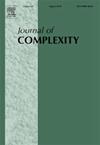Borell's inequality and mean width of random polytopes via discrete inequalities
IF 1.8
2区 数学
Q1 MATHEMATICS
引用次数: 0
Abstract
Borell's inequality states the existence of a positive absolute constant such that for every whenever X is a random vector uniformly distributed on any convex body and is the standard canonical basis in . In this paper, we will prove a discrete version of this inequality, which will hold whenever X is a random vector uniformly distributed on for any convex body containing the origin in its interior. We will also make use of such discrete version to obtain discrete inequalities from which we can recover the estimate for any convex body K containing the origin in its interior, where is the centrally symmetric random polytope generated by independent random vectors uniformly distributed on K, is the -centroid body of K for any , and denotes the mean width.
离散不等式与随机多面体的平均宽度
Borell不等式表明存在一个正的绝对常数C>;0,使得当X是均匀分布在任意凸体K≤Rn上的随机向量,且(ei)i=1n是Rn中的标准正则基时,对于每1≤p≤q(E b| < X,en > |p)1p≤(E| < X,en > |q)1q≤Cqp(E| < X,en > |p)1p。在本文中,我们将证明该不等式的一个离散版本,当X是一个均匀分布在K∩Zn上的随机向量时,对于任何在其内部包含原点的凸体K≠Rn,该不等式成立。我们还将利用这种离散版本来获得离散不等式,从中我们可以恢复对任何包含其内部原点的凸体K的估计Ew(KN) ~ w(Zlog ln N(K)),其中KN是由均匀分布在K上的独立随机向量生成的中心对称随机多面体KN=conv{±X1,…,±XN}, Zp(K)是K的任意p≥1的lp质心体,w(⋅)表示平均宽度。
本文章由计算机程序翻译,如有差异,请以英文原文为准。
求助全文
约1分钟内获得全文
求助全文
来源期刊

Journal of Complexity
工程技术-计算机:理论方法
CiteScore
3.10
自引率
17.60%
发文量
57
审稿时长
>12 weeks
期刊介绍:
The multidisciplinary Journal of Complexity publishes original research papers that contain substantial mathematical results on complexity as broadly conceived. Outstanding review papers will also be published. In the area of computational complexity, the focus is on complexity over the reals, with the emphasis on lower bounds and optimal algorithms. The Journal of Complexity also publishes articles that provide major new algorithms or make important progress on upper bounds. Other models of computation, such as the Turing machine model, are also of interest. Computational complexity results in a wide variety of areas are solicited.
Areas Include:
• Approximation theory
• Biomedical computing
• Compressed computing and sensing
• Computational finance
• Computational number theory
• Computational stochastics
• Control theory
• Cryptography
• Design of experiments
• Differential equations
• Discrete problems
• Distributed and parallel computation
• High and infinite-dimensional problems
• Information-based complexity
• Inverse and ill-posed problems
• Machine learning
• Markov chain Monte Carlo
• Monte Carlo and quasi-Monte Carlo
• Multivariate integration and approximation
• Noisy data
• Nonlinear and algebraic equations
• Numerical analysis
• Operator equations
• Optimization
• Quantum computing
• Scientific computation
• Tractability of multivariate problems
• Vision and image understanding.
 求助内容:
求助内容: 应助结果提醒方式:
应助结果提醒方式:


